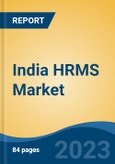Speak directly to the analyst to clarify any post sales queries you may have.
10% Free customizationThis report comes with 10% free customization, enabling you to add data that meets your specific business needs.
Key Market Drivers
Digital Transformation Across Enterprises Driving HRMS Adoption
The accelerating shift toward digital operations among Indian enterprises is significantly boosting the adoption of HRMS platforms. Businesses are modernizing human resource processes by replacing outdated systems with intelligent, cloud-based HRMS tools that manage payroll, recruitment, performance evaluation, and employee engagement. This transformation enhances workflow efficiency, data accuracy, and strategic alignment between HR and organizational goals. The rise of remote and hybrid work post-pandemic has underscored the necessity for flexible HR platforms that ensure regulatory compliance and business continuity. Cloud adoption, spurred by improved connectivity and Digital India initiatives, has also made HRMS solutions more scalable and cost-effective for SMEs. These platforms now integrate with ERP systems, analytics tools, and communication applications, positioning HRMS as a central component of enterprise digitization and strategic workforce management.Key Market Challenges
Fragmented Adoption Across Enterprise Sizes and Sectors
The HRMS market in India faces a significant challenge due to the uneven rate of adoption among various enterprise sizes and industries. While large corporations readily invest in advanced HR technologies, many small and medium enterprises continue relying on manual or semi-automated processes. Factors such as limited budgets, low awareness, and resistance to change inhibit adoption. Industries like traditional manufacturing and logistics prioritize operational functions over administrative automation, delaying digital integration. Additionally, cultural inertia in family-run businesses and lack of sector-specific customization in HRMS platforms hinder full-scale implementation. Without more tailored, accessible solutions, and a shift in perception around the value of HR tech, widespread adoption across the Indian business landscape remains constrained.Key Market Trends
Rise of Artificial Intelligence and Predictive Analytics in Human Resource Management
Indian businesses are increasingly incorporating artificial intelligence and predictive analytics into HRMS platforms to enhance workforce management. These technologies aid in automating routine HR tasks, optimizing recruitment strategies, forecasting attrition, and personalizing employee development. Predictive models based on historical data improve succession planning and productivity analysis, while AI-driven chatbots streamline interactions like employee queries and interview scheduling. The trend is supported by advancements in cloud infrastructure and real-time data analytics, positioning AI not just as an enhancement, but as a standard capability in modern HRMS. This integration is revolutionizing employee lifecycle management and enabling data-driven HR decision-making across industries.Key Market Players
- Zoho Corporation
- Tata Consultancy Services Limited
- SAP SE
- Oracle Corporation
- Ramco Systems Limited
- Automatic Data Processing, Inc.
- IBM Corporation
- Microsoft Corporation
Report Scope:
In this report, the India HRMS Market has been segmented into the following categories, in addition to the industry trends which have also been detailed below:India HRMS Market, By Business Application:
- Attendance & Leave Management System
- Payroll Management System
- Performance Management System
- Talent Management System
- Recruitment Tracking System
- Others
India HRMS Market, By End User:
- IT & ITeS
- BFSI
- Healthcare
- Government
- Manufacturing
- Retail
- Others
India HRMS Market, By Region:
- South India
- North India
- West India
- East India
Competitive Landscape
Company Profiles: Detailed analysis of the major companies present in the India HRMS Market.Available Customizations:
With the given market data, the publisher offers customizations according to a company's specific needs. The following customization options are available for the report.Company Information
- Detailed analysis and profiling of additional market players (up to five).
This product will be delivered within 1-3 business days.
Table of Contents
Companies Mentioned
- Zoho Corporation
- Tata Consultancy Services Limited
- SAP SE
- Oracle Corporation
- Ramco Systems Limited
- Automatic Data Processing, Inc.
- IBM Corporation
- Microsoft Corporation
Table Information
| Report Attribute | Details |
|---|---|
| No. of Pages | 80 |
| Published | June 2025 |
| Forecast Period | 2025 - 2031 |
| Estimated Market Value ( USD | $ 0.87 Billion |
| Forecasted Market Value ( USD | $ 2.27 Billion |
| Compound Annual Growth Rate | 17.3% |
| Regions Covered | India |
| No. of Companies Mentioned | 8 |









